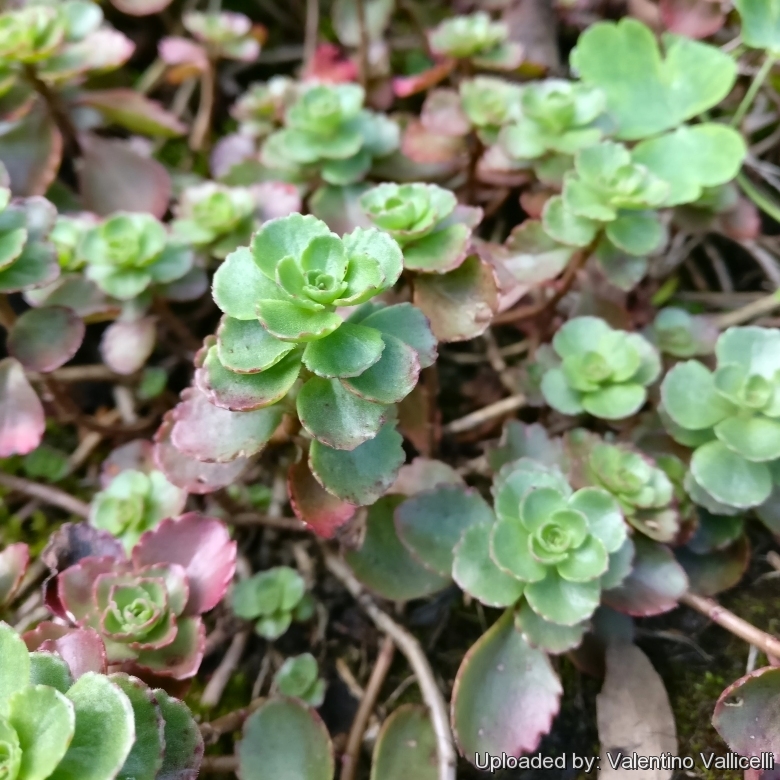Accepted Scientific Name: Sedum spurium M.Bieb.
Fl. Taur.-Caucas. 1: 352 1808. M.Bieb.

Phedimus spurius (Sedum spurium) Photo by: Valentino Vallicelli
Growing habit at Averliaz, France.
Origin and Habitat: Sedum spuriumSN|34356]]SN|34356]] is native to Georgia (Caucasus), Northern Iran, North-East Turkey (Anatolia) and is naturalized in many parts of Europe and in North America. .
Altitude range: 1250-3000 metres above sea level.
Habitat and ecology: This species grows in rocky sites and sub-alpine meadows.
Synonyms:
See all synonyms of Sedum spurium
back
Accepted name in llifle Database:Sedum spurium M.Bieb.Fl. Taur.-Caucas. 1: 352 1808.Synonymy: 17
back
Common Names include:
ENGLISH: Two-row sedum, Caucasian-Stonecrop
DUTCH (Nederlands): Roze vetkruid
FINNISH (Suomi): Kaukasianmaksaruoho
FRENCH (Français): Orpin bâtard
GERMAN (Deutsch): Kaukasus-Asienfetthenne
HUNGARIAN (Magyar): Kaukázusi varjúháj
PERSIAN (فارسی): ??? ??????
POLISH ( Polski): Rozchodnik kaukaski
RUSSIAN (Русский):
SPANISH (Español): Sedo bastardo
SWEDISH (Svenska): Kaukasiskt fetblad
WELSH (Cymraeg): Briweg y Cawcasws
Description: Sedum spurium is a vigorous, fast-spreading, mat-forming herbaceous succulent perennial native to the Caucasus Mountains. It produces numerous creeping, rooting stems up to 15 cm long and forms dense mats from 30-70 cm or more in diameter and 7.5 cm tall. Plants bear rounded evergreen leaves topped by rounded clusters of starry red, pink or white flowers in late summer. Like all those of the same genus, the the flowers of S. spurium have 5 petals and 5 stamens. It is a variable species in respect to size and dentation of the leaves and flower colour. It is widely cultivated and a number of cultivars are available. In flower this sedum is one of the most rewarding dwarf plants in cultivation.
Sterile stems: Procumbent or creeping, rooting, glabrous or somewhat papillose, 5-15 cm long often purple-tinted.
Roots: Creeping.
Leaves: Opposite or rarely alternate, grouped in rosettes, simple, sessile or shortly petiolate, spatulate to obovate or orbicular, base wedge-shaped, usually crenate (slightly toothed in the upper half, or whole), 15-35 mm long, 10-12 mm wide dark green to blue-grey with a gloss, often purple-tinted.
Inflorescence: Held on procumbent or ascending flowering branches up to 10-30 cm long and papillose. The inflorescence is a rather dense corymb with 3-5 branched cymes (terminal inflorescences) and 15-30 flowers. The bracts are oblanceolate to oblong, papillose.
Flowers: Small star-shaped, 5-merous (rarely 6-merous), subsessile or with short pedicels. Sepals deltoid-lanceolate, obtuse to acute, papillose towards tip, to 10 mm long. Petals erect in the lower part and usually spreading above, subovate, short- or sometimes long-mucronate, with slightly recurved tips, carinate, 7 - 12 mm long, pure white, pink or even crimson. Filaments 5-9 mm long. Anth red. Nectarie 0.5 x 1 mm.
Fruits: Fused at base, (sub-) erect, glabrous, 5-9 mm long.
Chromosome number: 2n = 28, 42.
Bibliography: Major references and further lecture
1) William Curtis, John Sims "Curtis's Botanical Magazine Or Flower-garden Displayed", Volume 17 Edward Couchman, 1803
2) 2) Urs Eggli "Illustrated Handbook of Succulent Plants: Crassulaceae" Springer Science & Business Media, 06 December 2012
3) 3) "Michigan Botanist" Michigan Botanical Club, 2007
4) 4) Barbara W. Ellis "Covering Ground: Unexpected Ideas for Landscaping with Colorful, Low-Maintenance Ground Covers" Storey Publishing, 09 November 2012
5) George Walden Schenk "How to Plan, Establish, and Maintain Rock Gardens" Lane Book Company, 1964
 Sedum spurium at Averliaz, France. (Sedum spurium) Photo by: Valentino Vallicelli
Sedum spurium at Averliaz, France. (Sedum spurium) Photo by: Valentino VallicelliSend a photo of this plant.The gallery now contains thousands of pictures, however it is possible to do even more. We are, of course, seeking photos of species not yet shown in the gallery but not only that, we are also looking for better pictures than those already present.
Read More... Cultivation and Propagation: Sedum spuriumSN|34356]]SN|34356]] is a hardy perennial well adapted to ornament rock work.











